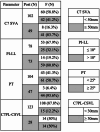Predicting postoperative imbalance in adult spinal deformity staged surgery using predictive thresholds
- PMID: 40885828
- PMCID: PMC12398600
- DOI: 10.1038/s41598-025-18031-9
Predicting postoperative imbalance in adult spinal deformity staged surgery using predictive thresholds
Abstract
Two-stage surgeries are increasingly used to minimize complications in adult spinal deformity (ASD) correction, yet the specific contributions of lateral lumbar interbody fusion (LLIF) and posterior column osteotomy/posterior spinal fusion (PCO/PSF) remain underexplored. This study evaluates their roles in deformity correction and establishes predictive thresholds for optimizing surgical planning. A total of 151 ASD patients (mean age 69.5 years) underwent staged LLIF and PCO/PSF surgeries one week apart. Radiographic parameters were analyzed preoperatively (Pre-), post- 1st LLIF (M-), post- 2nd PCO/PSF (Post-), and at two-year follow-up (F-). Correction rates were 80.9% for PI-LL mismatch (35.5% LLIF, 64.5% PCO/PSF), 40.5% for pelvic tilt (39.4% LLIF, 60.6% PCO/PSF), and 69.1% for C7 SVA (45.7% LLIF, 54.3% PCO/PSF). Coronal correction of the Cobb angle reached 76.7% (33.1% LLIF, 66.9% PCO/PSF). Significant ODI and SRS-22 score improvements were noted at two years. Predictive thresholds for imbalance were M-SVA 75.3 mm, M-PI-LL 32.5°, and M-PT 35.5°. The 2nd PCO/PSF contributes more to correction, and predictive thresholds aid surgical planning, reducing postoperative imbalance for better outcomes.
Keywords: Adult spinal deformity (ASD); Imbalance; Lateral lumbar interbody fusion (LLIF); Posterior column osteotomy (PCO); Stage surgery.
© 2025. The Author(s).
Conflict of interest statement
Declarations. Competing interests: The authors declare no competing interests. Ethical approval: The study protocol was approved by the Institutional Review Board of our hospital (Approval Number CMUH111-REC1-128) and performed in accordance with Declaration of Helsinki. Informed consent was obtained from all participants.
Figures







References
-
- Takemoto, M. et al. Sagittal malalignment has a significant association with postoperative leg pain in adult spinal deformity patients. Eur. Spine J.25, 2868–2875 (2016). - PubMed
-
- Häkkinen, A. et al. Spinopelvic changes based on the simplified SRS-Schwab adult spinal deformity classification: relationships with disability and health-related quality of life in adult patients with prolonged degenerative spinal disorders. Spine42, E304–E310 (2017). - PubMed
-
- Li, G. et al. Adult scoliosis in patients over sixty-five years of age: outcomes of operative versus nonoperative treatment at a minimum two-year follow-up. Spine (Phila Pa. 1976). 34, 2165–2170 (2009). - PubMed
-
- Smith, J. S. et al. Risk-benefit assessment of surgery for adult scoliosis: an analysis based on patient age. Spine (Phila Pa. 1976). 36, 817–824 (2011). - PubMed
-
- Bridwell, K. H. et al. Does treatment (nonoperative and operative) improve the two-year quality of life in patients with adult symptomatic lumbar scoliosis: a prospective multicenter evidence-based medicine study. Spine (Phila Pa. 1976). 34, 2171–2178 (2009). - PubMed
MeSH terms
LinkOut - more resources
Full Text Sources
Medical
Research Materials
Miscellaneous

